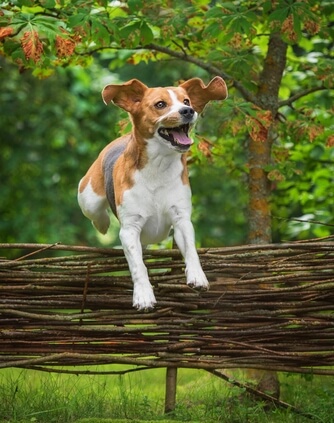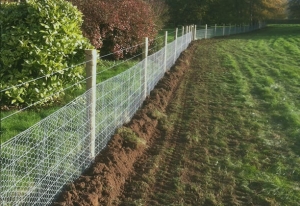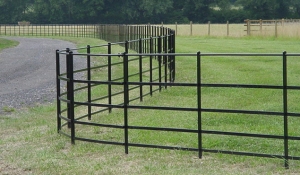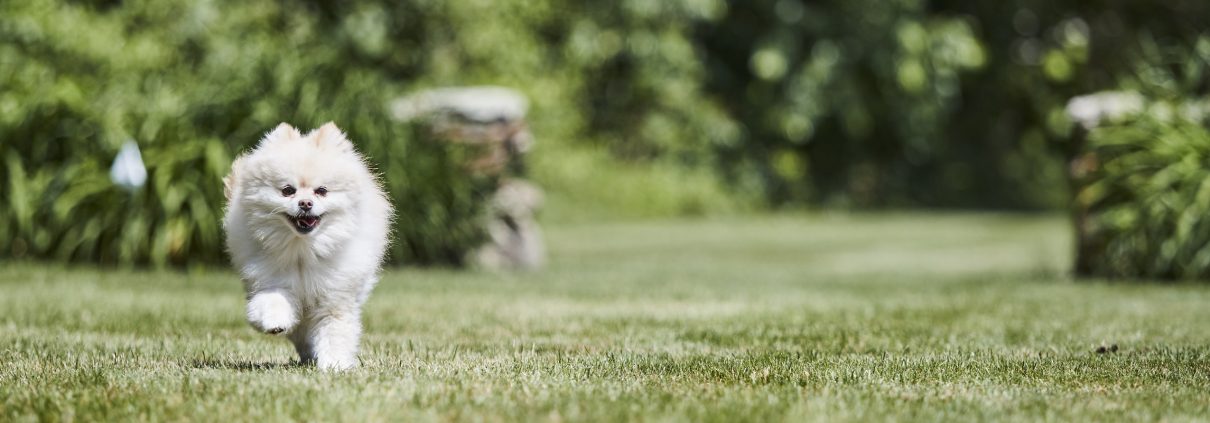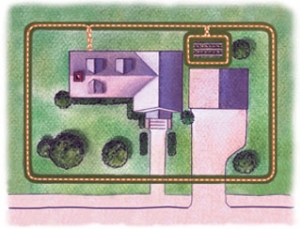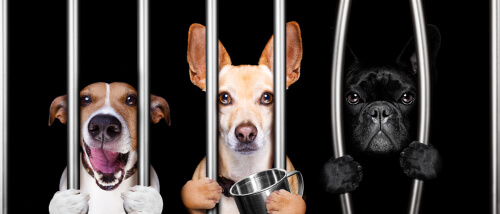Tag Archive for: dog fence legal
Affordable dog fencing – what are the options?
Affordable dog fencing
When it comes to affordable dog fencing there aren’t many options as fencing is actually quite expensive. As with everything you get what you pay for and it depends on whether you want to get your hands dirty. Naturally, these fencing options are based on how large an area you need to fence. The landscape that you need to fence. And also the breed of the dog that requires the dog fencing!
Dog fencing for small areas
If you are looking to fence a small back garden then it is likely that you already have a fence or wall but it isn’t meeting your needs. Watch your dog and see if he is using something to climb up and scrabble over or is he climbing or digging. Consider installing trellis above your fence. This can be bought from any good DIY store and is relatively quick to install. If you have a digger add a concrete footer below your fence by pouring concrete along the edge of the fence and sinking the bottom of the fence into the concrete before it dries. This is naturally a labour intensive job but should do the trick!
If you are not sure where he is getting out then one of our DIY dog fences is going to be the cheapest way forward. These fences are under £250.00 and will cover a small urban garden. If you compare the price of re-fencing a complete rear garden versus adding an electronic dog fence the dog fence will win on price all day long!
For small gardens with low fences, you may be able to upgrade your fence to a close board fence. These fences start at around £38.00 per metre fully installed. You will need to check that you can install a fence of this height before ripping out the old fence.
Rural gardens and small paddocks
It goes without saying that dog fencing for rural areas can be a headache. Not only are you trying to stop your dog going out but the local wildlife is busy pushing its way in. If you have an issue with rabbits and small dogs then this could be a good option for you but it is not the cheapest! Rabbit fencing starts at approx £130.00 per 50m without installation! If you are covering a 1-acre site this will cost in the region of £690.00 just for the galvanised mesh without any posts of labour. Also unless it is extremely well-installed rabbit fencing can be damaged by larger mammals such as Badgers, Muntjack and larger Deer.
If you have hedges or areas with no existing fences then the cheapest form of fencing will be either a stock fence or an electronic dog fence. If you have horses or livestock then you will need to look at stock fencing options. Of course, if it is only a dog or a cat that needs containing then an electronic dog fence is by far the cheapest option.
Our DIY dog fence can be expanded up to an acre for an additional £100.00 and a Professionally Installed dog fence will cost in the region of £1000.00 depending on the location and number of dogs. This would work out more cost-effective than the galvanized or stock fencing and would also protect the driveways. Installing gates can also be very costly and of course, this relies on people shutting the gate when they come or go! Our Professionally installed fences have a lifetime warranty on the hardware and a containment promise for the dog.
Large estates and difficult terrains
If it aesthetics then Estate fencing is most certainly the winner but you will need deep pockets to install this timeless classic! At around £80.00 per 2m panel + installation, it will very soon add up, especially on the large country estate! Again, you will need to think about gates and this type of fencing is not dog secure. Other popular types of fencing are post and rail with stock fencing below or chain link fencing. Chain link fencing is probably the cheapest starting from around £2500 for 1 acre + installation. Whereas if you are looking at fencing 10 acres using our Performance Series on a 10-acre site the cost would be circa £1800.00 including installation & training.
Riverbanks and Undulating Terrain
If your property goes down to the river you may be able to install a small picket fence. These will not stop all dogs as they tend to only be a 90 cm – 100cm high. Prices for Picket fencing start at around £12.00 per metre plus installation. Alternatively, you can use our dog fence to run along the boundary. This will keep your dog out of the river without disrupting the view. If you have very undulating terrain then you will probably need to install a stock fence but there would be a hefty surge-charge to install this! Again, an invisible fence can be installed for a fraction of the cost. The trencher used to install the invisible dog fence is extremely adaptable and be operated in both steep and undulating terrain. Images of the dog fence trencher can be seen on our installation & training page.
Dog Fencing price summary
Based on an acre (and excluding gates)
-
- Electronic dog fence (1 dog fully installed – covers gateways as well) – from £3.50 per metre installed.
- Stock Fencing (no gates) – from £7.00 per metre installed
- Rabbit Fencing (no gates) – from £8.00 per metre installed
- Stock Fencing with post and rail (no gates) – from £12.00 per metre
- Picket fencing (no gate) – from £20.00 per metre
- Close board fence (no gate) – from £35.00 per metre installed
- Estate fencing (no gate) from £40.00 per metre installed
Prices have been based on submissions from Companies in Berkshire (2019). Prices are based on properties in the local area and are a guide.
If you have been searching for dog fencing options then read our testimonials on our Trust Pilot reviews. If you would like more information or prices call us today on 03450 623623 or complete our quote form.
Electric dog fence – the myths and the truth!
What is an electric dog fence?
Electric dog fences have recently made the news. Just like Marmite, they are a contentious issue; people are either strongly for or violently against these systems.
Actually, there is no such thing as an electric dog fence. The correct name for a dog fence is a radio dog fence. A dog fence does not have any electricity in the cable and is physically incapable of electrocuting a dog or a cat. Of course, we all know that electric fence is a system used to keep livestock within an area. This type of fencing does have electricity running through the wire or net and is able to deliver an electric shock.
How does a dog fence work?
With a dog fence, the boundary wire carries a harmless radio signal. The dog or cat wears a computer collar which is programmed to pick up the radio signal. The size of the radio field can be altered to the size or breed of the pet. When the pet enters the radio signal zone the collar wakes up and gives out a high pitched warning beep. Should the pet continues further into the zone the collar gives out a static impulse; not an electrical shock. The impulse is similar to a Tens machine or abdominal exercise machine and is completely safe and harmless. The impulse is called a “correction” as it is designed to startle the pet and train them to avoid the area. The label “electric dog fence” is usually given as people assume that an electric shock is delivered when nothing could be further from the truth!
How does an electric fence work?
An Electric Fence is an electrical circuit that is charged by an electric fence energizer. A high voltage current is sent through the wire, tape or netting. The charge is sent through the fence in 1-2 second intervals. The fence acts as an open circuit. This becomes complete when an animal or person standing on the ground touches it. If an animal touches the wire the circuit closes and the current passes through the animal to deliver an electric shock.
Dog fences are cruel!
Interestingly, recent research has proved that dog fences are far from cruel, in fact, it has been proved that they save lives. Research carried out via the UK Government in conjunction with containment fence Companies and also a privately funded study through Lincoln University has proved that containment fences save lives.
Professor Daniel Mills an eminent Feline Expert “While some will argue that electronic containment systems can never be justified for pets, others highlight that, in the UK alone, hundreds of thousands of cats are killed and injured on roads each year and these devices can prevent these often fatal injuries and the emotional cost to the cats and their owners. In contrast, housing cats solely indoors to remove such risks is associated with increased prevalence of a range of health problems including obesity, Feline Urologic Syndrome and dental disease. Long-term exposure to common flame retardants widely used in homes may also have toxic side effects for cats.”
Sheep Attacks
Rising dog attacks on sheep also highlight the welfare issue that stray dogs can cause to other livestock. Stray dogs can kill sheep, cats and cause RTA’s. Farmers in many areas support the use of “electric dog fences” to keep their own stock safe. In Scotland, the increasing dog attacks on sheep has led to a public consultation regarding changing the law through a Protection of Livestock bill. Whilst the #takethelead campaign is a good starting point. Many dog attacks on livestock are from dogs that have escaped from the property. Similarly, leads can break and collars can be incorrectly fitted so training your dog not to chase sheep is a must.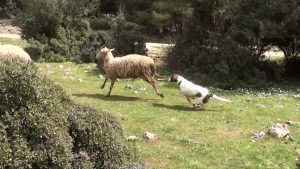
Far from being cruel dog fences save lives. Much better a small static impulse and some training than the bullet of a gun or being PTS by on a court order.
Can you use an electric fence for pets?
There is no law banning the use of electric fencing for dogs or cats. Whilst the voltage on these systems is very high no testing has been carried out to determine the long effects. There are certain safety features found within “electric dog fences” that are not found in electric stock fences.
Dog Fence verses Electric Fence
- Dog Fence – audible warning as pet approaches
- Electric fence – no warning until pet touches the wire
- Dog Fence – Automatically shuts down after 15 seconds to prevent distress
- Electric fence – will continue to shock until the pet is released.
- Dog Fence – can be used under driveways and open areas
- Electric fence – can only be used where no access is required
- Dog Fence – a static correction is humane
- Electric Fence – high levels of shock may not be good for pets.
Sadly the media and social media groups have given dog fences a bad name. Both research and those that use these fences prove that these systems save pets lives. The label electric dog fence naturally conjures up the idea of a dog being electrocuted or wired up to the electricity. Nothing could be further from the truth. We all accept that sometimes we have to deliver a small amount of discomfort to save a life. We vaccinate our pets and we microchip pet, both of which cause moderate discomfort. Yet we hear the cries of cruel and barbaric when we discuss dog fences.
Is this because people do not understand how they work or how they feel? These blogs are designed to be open and honest about how the systems work and if you would like to learn more please call us on 03450 623623 or visit our web site https://dogfence.co.uk/.
Electronic dog fences – are they safe for small dogs?
Are electronic dog fences safe to use for small dogs?
Electronic dog fences have been around for over 40 years. Unsurprisingly in the early years this type of electronic dog fencing was most certainly not suitable for small dogs. Why were they not suitable? Size and weight of the computer collars! Many of the early collars used a 9 volt battery to power the collar which was both bulky and heavy. As with mobile phones recent advances in technology have enabled the size and weight of the computer collars to be dramatically decreased.
At DogFence we are proud to be able to offer the smallest and lightest electronic dog fence collars on the market today. Our mini computer collars weigh only 30g including the small 3.0 volt battery. Our electronic dog fence collars are suitable for all breeds of dogs and cats and with the increasing popularity of toy breeds our sales of mini collars has risen significantly in the last 5 years.
Will the electronic dog fence hurt my dog?
Naturally a common concern is that the “correction” or impulse will hurt the dog. Naturally, at DogFence we are all dog lovers and the last thing we would want to do is inflict pain or suffering onto any dog or cat. The impulse level is set to each dog or cats personality. People often asks does it hurt? can I feel it? In reality, once they feel the impulse the next reaction is usually “how will that keep my dog in?” or “oh it’s not that bad!”.
Electronic dog fences have been tested by leading Universities and pet professionals across the world. The results have proved that these fences are safe to use with both dogs and cats. The amount of impulse delivered is not determined by the size of the pet but their personality. The average setting for most dogs is level 2 this would equate to some 250 times lower that a cattle of electric stock fence.
Interesting, the impulse is generally only received during the training phase. All our electronic dog fence collars give out a warning beep prior to giving out the impulse. During the training phase the pet also has a visual marker with training flags. If the training is carried out correctly the pet will rarely receive any activation after the initial period. All our DogFence installers are qualified to train your dog or cat to the containment system. DogFence is a member of the IACP an international organisation set up for training dogs using electronic stimulation alongside conventional training protocols.
Will I have to use the electronic dog fence forever?
This is always a difficult question to answer. It really depends on your dog’s personality and hunting drive. As a rule we find that dogs and cats that are trained before the escaping behavior begins will train quickly and easily and never challenge the fence. However, if you have livestock or game birds nearby and a dog with a high drive then it is advisable to use the system everyday. With electronic dog fencing consistency is king. If every time the dog enters the zone they hear the warning beep they will not “challenge” the fence. Issues can arise if they can go through the zone one day because they are not wearing the electronic dog fence collar and not on another day it becomes confusing to the pet.
What do the Experts Say?
Recent studies through Lincoln University, headed by the well revered Prof. Daniel Mills, and the Governments research have proved that electronic dog fences are only safe and also save the lives of dogs and cats. With modern technology size is no longer a barrier to pet containment with an electronic dog fence. Read more about what the experts say on our web site.
If you would like to learn more about how an electronic dog fence can keep your pet safe contact us on 01628 476475 or email us @ info@dogfence.co.uk.
Dog fences are NOT banned!
Dog fences & Cat fences are not banned!
After the government bought containment fences to a public consultation, it was decided that Dog fences are NOT banned. This landmark decision also has had a positive impact for all you cat lovers – Cat fences are not banned either! Considering the statistics of cats that are injured and killed on the UK’s roads each year this is fantastic decision. Farmers are also relieved that dog fences (aka containment fences) are exempt from the proposed e-collar ban. In the last few years dog attacks on livestock have risen dramatically.
So what is a Dog fence?
A dog fence is an invisible fence that will give your pets freedom in your garden. As pet owners, it gives you peace-of-mind knowing your pet is not escaping, chasing livestock or getting onto the roads. It works silently, invisibly 24/7 covering all boundaries including driveways and open areas. Dog fences have been around for over 40 years. Sadly the modern systems are often maligned without people really understanding how they work.
How do Containment fences work?
A central control box is connected to a boundary wire that usually runs around the perimeter of the property. The control box sends a coded radio signal through the boundary wire that has been laid around the property. The size of the signal emitted by the control box can be enlarged or reduced according to the customers’ requirements.
The collar that your pet wears, houses a tiny FM receiver. As the pet moves towards the signal the collar emits an audible signal to indicate to stop. If the pet continues towards the wire the collar gives a small “corrective impulse” set to the pet’s individual requirements. To some this idea is unthinkable but the impulse is akin to a static shock that you might get if you touch a door knob. When considering a cat fences the containment fences are the only option for giving cats complete freedom and safety in one package.
Why is it so important that Containment fences are not Banned?
With Dog’s & Cats accounting for 16% of reported animal deaths on major roads in the UK over the past 24 months, it is more important than ever to keep your pets safe at home. With over 80% of the people surveyed admitting that they would swerve to avoid hitting a Dog, the question would then be – By swerving what others accidents could this cause? Nobody wants to see Dogs killed on our roads and this is why the message of “Dog fences are not banned” is critical.
And its not just the roads which will be a safer place – Farmers around the UK are also celebrating. Dogs form a critical function on the farms, including companionship, protection and the herding of animals. Just as important though – properties that border the farms with livestock generally use these containment fences to stop the dogs entering the fields and attacking the livestock.
Containment fences are NOT banned! Why Not?
The Consultation lasted 6 weeks ending in April’18 and it was clear that banning containment fences would be a mistake. The public spoke and Over 64% of all the responses received were in favour of retaining Containment fences. The study by Lincoln University which was published in 2016 gave cat fences a positive thumbs up.
In a letter from DEFRA dated February’18 (Before the announcement of the consultation) it was stated:
“The evidence from the studies was not strong enough to support a ban on the devices under the Animal Welfare Act 2006. The claim that electronic training aids may be no more effective than other training methods is not in itself a reason to introduce a ban or to impose restrictions on their use. Having said that, our advice is that electronic training aids should only be used as a last resort and on the recommendation of a professional such as a vet, a suitably qualified dog behaviourist, or a dog trainer, and should only be used by competent operators.”
If nothing else the consultation into the use of containment fences has proved that they are a valuable and effective system. Thankfully thousands of owners submitted stories of how the dog fence or cat fence had saved their pets life. It goes without saying that these positive stories were instrumental in assisting the Government to exempt dog fences.
Changes to dog fence legislation
The Government has announced that they will implement new regulations into the installation of dog fences. These regulations will be to ensure that dog fences and cat fences are correctly installed and that the owners are given the correct training for their pets. DEFRA consulted with DogFence Ltd as our Company pioneered the full installation and training service to the UK. Since 2003 DogFence Ltd have been offering full installation with training for their pets to the dog fence or cat fence systems.
Where can I find out more about Dog fences?
DogFence Ltd are the UK leading installers of containment fences offering full installation and training for your pets. If you would like more information about the system and the costs call us on (01628) 476475 or click here.
Freedom fence, Invisible Fence, What are they?
What is a freedom fence or Invisible fence?
So what is a freedom dog fence? it’s actually is a generic name for an electronic dog fence. Very similar to a “hoover”, a freedom fence, invisible fence or DogFence are often used to describe the containment fences. These dog fences were first produced in the USA over 40 years ago.
The History of Invisible Fences
Electronic pet containment systems originated in the year 1973. The overall concept began due to humanitarian emotion from American Richard Peck. Peck was a salesman in Pennsylvania selling his company’s metal cutting and welding services.
“I traveled the United States and everywhere I went, I literally saw hundreds of dogs that had been slaughtered by cars. They were all over the roadway,” Peck said years later. “I loved dogs and knew there had to be a way to stop this.”
The development of dog fences
In 1973, Peck partnered with an electronic engineer and patented the first electronic dog fence system. The collar was placed on a pet and received radio waves from a wire buried beneath the ground. The radio waves were transmitted through the wire from a transmitter protected inside the house. When the radio waves are received by the collar, it sends a brief uncomfortable static shock under the pet’s skin. The “shock” deters the pet from traveling farther into a designated zone. In todays’ world date the word “shock” should be replaced by stimulation as the impulse produced is incredibly low and incapable of inducing a state of shock.
Always concerned for dog safety, Peck worked with the University Of Pennsylvania School Of Veterinary Medicine. Together they conducted extensive research on the short-and long-term effects the new system would have on animals. The study proved it was extremely effective for influencing behavior of animals and keeping them contained in a specified area. Furthermore, the study proved that pets that were contained by a freedom dog fence had no long-term ill effects from the stimulation.
No boundary gardens
The late 1970s in the USA there was a rise in the popularity of housing estates forbidding traditional fencing. This made it almost impossible to have a large dog. Naturally with the new “invisible fence systems” quickly became popular. Peck initially sold the systems through catalogs and direct mail. The growth of the company was very slow. There were only 50 systems sold the first year. The fences were promoted by two nationally distributed dog magazines, Dogs and Dog Fancy.
Peck retired in the early 1980s and sold his company to private entrepreneurs outside of Philadelphia. These entrepreneurs invested in product improvements and named the product “Invisible Fence.” The engineering staff began refining the technology of the existing product. The company began selling a compact, lighter version of the receiver collar that went from 13 ounces down to 3 ounces. Thus the market was opened so that smaller dogs and cats could utilize the Invisible Fence solution.
New Manufacturers enter the market
In 1990, the overall patent for the technology expired and other companies to began to appear. This led to the rise in other manufacturers, PetSafe, DogWatch, and Innotek. These Companies have produced their own version of the original invisible fence. The early systems were not available for self-installation and Freedom Fence Dealers were part of the PetSafe network that started offering installation across the USA.
The market went worldwide
Dog Fence, Invisible Fence and Freedom Fence dealers started to import the technology into Europe and Australia. These markets were mainly self-installation markets and over time some dealerships started to offer a limited installation service through agents and part-time sub-contractors.
In the UK there were 3 Companies offering Installation for freedom dog fences:
Invisible Fence
The original Invisible Fence UK Dealer has recently retired after selling both Invisible Fence and Innotek systems for over 25 years. Most of the Invisible dog fences were sold for self-installation.
Freedom Fence
This business model is slightly different and is made up of a large number of representatives who work on a sub-contract basis. These individuals will install the PetSafe and PetSafe Professional brand of dog fence. PetSafe fences use the same AM technology that was used to produce the original Invisible Fence systems. As these are part time representatives they do not all offer the same level of service.
DogFence
DogFence Ltd were the first Company to offer complete onsite Professional Installation & Training for dogs and cats. This Company uses the DogWatch brand of hidden fence which was developed using an FM radio frequency. When it comes to technology the FM signal is far safer and faster than the AM operated fences. DogFence Ltd pioneered bringing the full installation & training service to the UK. Unlike Freedom Fence the installers are all employed by DogFence. This gives consistency in quality of service and equipment standards.
Why is Technology Important?
Arguably most peoples pets are part of their family, they are as important as children or siblings. Naturally one wants to do everything they can to protect them which is why they install a dog fence. As with your car it is important to look at safety features within each product.
The Original Invisible Fence used an AM radio signal. This was mirrored by all manufacturers except DogWatch (DogFence). DogWatch inc were concerned about the high numbers of false activation on the receiver collars with AM. The dog may not be in the zone but the collar was activated because the collar picked up a similar signal. It is for this reason that they decided to explore using an FM signal. After developing and patenting the FM signal it quickly became clear that this was a far superior channel.
Why is the FM signal safer? The reason for the FM signal is to ensure that nothing else can activate the dog or cats computer collar. The Freedom Fence and Invisible Fence brands use OOK (on/off keying). With OOK the collar is open to picking up other signals when it is in the “down” time. This means that the collar can activate when the pet is not in the “no go zone” as it has “heard” another signal.
With the DogFence system the signal is constant and the collar can only read the programmed signal. In order to reduce case of false activation freedom fence and invisible fence systems use a 2nd signal to reduce confusion. Naturally checking for 2 signals slows down the reaction time on the collar.
Why does speed affect the dog fence?
Put simply if your dog is racing towards the no go zone the collar needs to stop him before he runs into the road. With the DogFence system if he runs at 10mph he will only get 0.125ft into the zone before the collar has given a warning beep and impulse. With a freedom fence he will be at 7ft before the collar has activated. Conversely many people never consider the shut down time on the fence. What happens if the dog retreats? How quickly will the collar stop? Again, speed is crucial the start up and the shut down times are equal. If your dog retreats the FM fences will shut down in less than 1 second. With the PetSafe, Invisible Fence and Freedom Fences AM brands the time is 2 – 5 seconds. Food for thought!
Conclusion
Today there are well more than 2 million freedom dog fence systems installed worldwide. Recent studies by Lincoln University and the UK Governments consultation have proved that these fences save the lives of dogs and cats. It maybe that you are skeptical or adverse to the idea of using a Freedom dog fence but those that use them swear by them. A few of the comments from the Government consultation can be read here:-
If you would like to obtain more information on our containment fences call us (01628) 476475 or click here.
Are electric dog fences legal?
Are electric dog fences legal?
So you’ve read the recent media reports and are confused about whether electric dog fences are legal. If you are concerned about your pet’s safety and want to use an electric dog fence read on …..

The good news is if you are considering installing an electric dog fence they are completely Legal to use in England. Our dogs and cats can have their freedom and safety!
In March 2018 the Government launched a consultation into the use of all electronic dog and cat collars. Over a 6 week consultation period 7000+ people responded. Interestingly, the majority of people (64%) were opposed to a ban. The Government looked at the evidence and the research for both the hand held units (aka remote training collars) and containment fences (aka electric dog fences). In August the Government announced that they would not ban invisible dog fence systems. They went on to state that these fence systems offer safety to pets.
Are there any regulations for installing a electric dog fence?
After considering the evidence the Government noted that in the interests of pet welfare containment fences must be Professionally installed. They . From Autumn 2018 all containment fences will have to be professionally installed with onsite training for the cat or dog.
What do I get with Professional Installation?
So what does Professional Installation give the customer? Firstly extensive knowledge as well as advise and a good standard of product. Companies that offer full installation will have correctly trained their operatives. The operatives will be trained to know where to place the wire and how to correctly train the pet. These Companies will have also researched the best products in terms of durability and safety. If a product is constantly breaking down due to poor quality of wire or hardware it will leave the pet vulnerable.
When installing an electric dog fence correct placement of the cable is crucial. Ideally the cable will be buried to avoid damage. In situations where burial is not possible the Installer will find a safe position above the ground. The product sold should have in-built safety features to protect the pet. This will include automatic shutdowns, a low battery warning and a good long battery life. It is important to consider that if the battery runs out the pet could run out! When installing the cable advice should be given on areas to avoid and where possible the cable should follow natural boundaries.
Once the fence has been installed the Professional should train the cat or the dog for the owner. Ongoing guidance and support should be part of the service. A reputable Installation Company should keep records of the pets individual requirements and offer a follow up service for the future.
How do I know if I am getting a Professional Installation?
Companies that offer full installation will have a proven track record so it will be easy to ask for references and check reviews. They should also offer installation using the trenching equipment and post installation service. Using a one man band or sub-contractor may not meet the Professional Installation regulations require. Due to the high cost of the installation equipment it is unlikely that these individuals will have access to correct installation tools and are most likely not trained. Furthermore a reputable installation Company will usually offer a good guarantee regarding their product and service.
Intrigued and want to learn more? call us on: 03450 623 623 or email us on: info@dogfence.co.uk today.

